Stellar Evolution I - Solar Type Stars
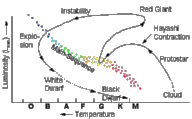

| Gene Smith's Astronomy Tutorial Stellar Evolution I - Solar Type Stars |
 |

The actual process of star formation remains shrouded in mystery because stars form in dense, cold molecular clouds whose dust obscures newly formed stars from our view. For reasons which are not fully understood, but which may have to do with collisions of molecular clouds, or shockwaves passing through molecular clouds as the clouds pass through spiral structure in galaxies, or magnetic-gravitational instabilities (or, perhaps all of the above) the dense core of a molecular cloud begins to condense under its self-gravity, fragmenting into stellar mass clouds which continue to condense forming protostars. As the cloud condenses, gravitational potential energy is released - half of this released gravitational energy goes into heating the cloud, half is radiated away as thermal radiation. Because gravity is stronger near the center of the cloud (remember Fg ~ 1/distance2) the center condenses more quickly, more energy is released in the center of the cloud, and the center becomes hotter than the outer regions. As a means of tracking the stellar life-cycle we follow its path on the Hertzsprung-Russell Diagram.
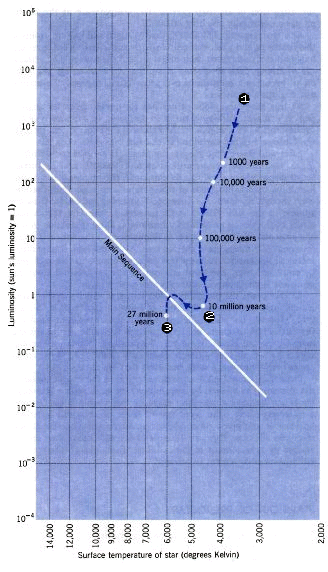
1. Protostar
The initial collapse occurs quickly, over a period of a few years. As the
star heats up, pressure builds up following the Perfect Gas Law:
2. Pre-Main Sequence
Once near-equilibrium has been established, the contraction slows down, but
the star continues to radiate energy (light) and thus must continue to contract
to provide gravitational energy to supply the necessary luminosity. The star
must continue to contract until the temperatures in the core reach high enough
values that nuclear fusion reactions begin. Once nuclear reactions begin in
the core, the star readjusts to account for this new energy source
Gravity releases its potential energy
throughout the star, but due to the very high temperature dependence of the
nuclear fusion reactions, the proton-proton chain is highly centrally
concentrated. During this phase the star lies above the main sequence;
such pre-main sequence stars are observed as
T-Tauri Stars, which are going through a phase of high activity.
Material is still falling inward onto the star, but the star is also spewing
material outward in strong winds or jets as shown in the
HST Photo
below.
3. Zero Age Main Sequence
It takes another several million years for the star to settle down on the
main sequence. The main sequence is not a line, but a band in the H-R
Diagram. Stars start out at the lower boundary, called the Zero-Age
Main Sequence referring to the fact that stars in this location have
just begun their main sequence phases. Because the transmutation of Hydrogen
into Helium is the most efficient of the nuclear burning stages, the main
sequence phase is the longest phase of a star's life, about 10 billion yrs
for a star with 1 solar mass.
5. Post Main Sequence
6. Red Giant - Helium Flash
As the Helium core of the star contracts, nuclear reactions continue in a
shell surrounding the core. Initially the temperature in the core is too
low for fusion of helium, but the core-contraction liberates gravitational
energy causing the helium core and surrounding hydrogen-burning shell to
increase in temperature, which, in turn, causes an increase in the rate of
nuclear reactions in the shell. In this instance, the nuclear reactions are
producing more than enough energy to satisfy the luminous energy output.
This extra energy output pushes the stellar envelope outward, against the
pull of gravity, causing the outer atmosphere to grow by as much as a factor
of 200. The star is now cool, but very luminous - a Red Giant.
(You do the arithmetic: 200 x 700,000km = ?; where will the outer radius of the sun be?)
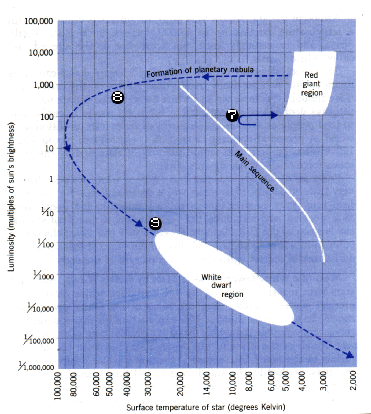
7. Helium Burning Main Sequence
Once again the core of the star readjusts to allow for a new source of energy,
in this case fusion of Helium to form Carbon via the Triple-Alpha Process.
The Triple alpha process releases only about 20% as much energy as hydrogen
burning, so the lifetime on the Helium Burning Main Sequence is only about
2 billion years.
resulting in the formation of a Carbon-Oxygen core. When the Helium is exhausted in the core of a star like the sun, no further reactions are possible. Helium burning may occur in a shell surrounding thecore for a brief period, but the lifetime of the star is essentially over.
8. Planetary Nebula
 When the helium is exhausted in the core of a star like the sun, the C-O core
will begin to contract again. Central temperatures will never reach high
enough values for Carbon or Oxygen burning, but the Helium and Hydrogen
burning shells will conyinue burning for a while. Throughout the star's
lifetime it is losing mass via a stellar wind, like the solar wind. This mass
loss increases when the star swells up to the size and low gravity of a Red
Giant. During Helium Burning, thermal pulses, caused by the extreme
temperature sensitivity of the 3-alpha Process, can cause large increases in
luminosity with accompanying mass ejection. During Helium Shell Burning, a
final thermal pulse produces a giant "hiccough" causing the star to eject as
much of 10% of its mass, the entire outer envelope, revealing the hot inner
regions with temperatures in excess 100,000K, shown in this
animation of the Helix, below. The
resulting
Planetary Nebuala
is the interaction of the newly ejected shell of gas with the more slowly
moving ejecta from previous events and the ultraviolet light from the hot
stellar remnant, which heats the gas and causes it to fluoresce. The Ring
Nebula in Lyra (Messier
Database, Web
Nebulae) shown below is
When the helium is exhausted in the core of a star like the sun, the C-O core
will begin to contract again. Central temperatures will never reach high
enough values for Carbon or Oxygen burning, but the Helium and Hydrogen
burning shells will conyinue burning for a while. Throughout the star's
lifetime it is losing mass via a stellar wind, like the solar wind. This mass
loss increases when the star swells up to the size and low gravity of a Red
Giant. During Helium Burning, thermal pulses, caused by the extreme
temperature sensitivity of the 3-alpha Process, can cause large increases in
luminosity with accompanying mass ejection. During Helium Shell Burning, a
final thermal pulse produces a giant "hiccough" causing the star to eject as
much of 10% of its mass, the entire outer envelope, revealing the hot inner
regions with temperatures in excess 100,000K, shown in this
animation of the Helix, below. The
resulting
Planetary Nebuala
is the interaction of the newly ejected shell of gas with the more slowly
moving ejecta from previous events and the ultraviolet light from the hot
stellar remnant, which heats the gas and causes it to fluoresce. The Ring
Nebula in Lyra (Messier
Database, Web
Nebulae) shown below is
HST images of Planetary Nebulae: The Ring Nebula and the young Planetary Nebula known as MyCn18, the Hourglass Nebula.
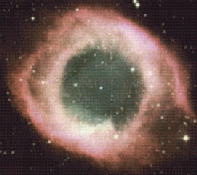 |
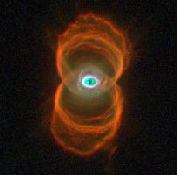 |
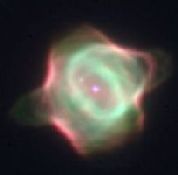 |
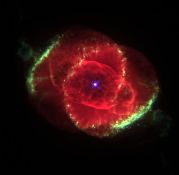 |
| The Helix | MyCn18 | Hen-1357 | NGC 6543 |
9. White Dwarf
As the nebula disperses, the shell nuclear reactions die out leaving the
stellar remnant, supported by
electron
degeneracy, to fade away as it cools
down. The white dwarf is small, about the size of the earth, with a density
of order 1 million g/cm3, about equivalent to crushing a volkswagen
down to a cubic centimeter or a "ton per teaspoonful."
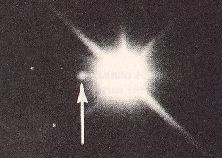
A white dwarf star will take billions of years to radiate away its store of thermal energy because of its small surface area. The white dwarf will slowly move down and to the right in the H-R Diagram as it cools until it fades from view as a "black dwarf". To the right is the white dwarf companion to the nearby star Sirius.
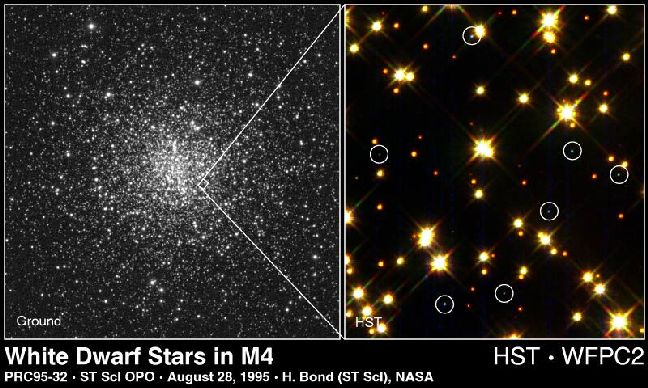

![]() Stellar Evolution #2
Stellar Evolution #2
![]() Nuclear Reactions
Nuclear Reactions
![]() Education & Outreach
Education & Outreach
![]() CASS Home
CASS Home
Conducted by Gene Smith, CASS/UCSD.
Comments?
You may send email to hsmith@ucsd.edu
Prof. H. E. (Gene) Smith
CASS 0424 UCSD
9500 Gilman Drive
La Jolla, CA 92093-0424
Last updated: 16 April 1999